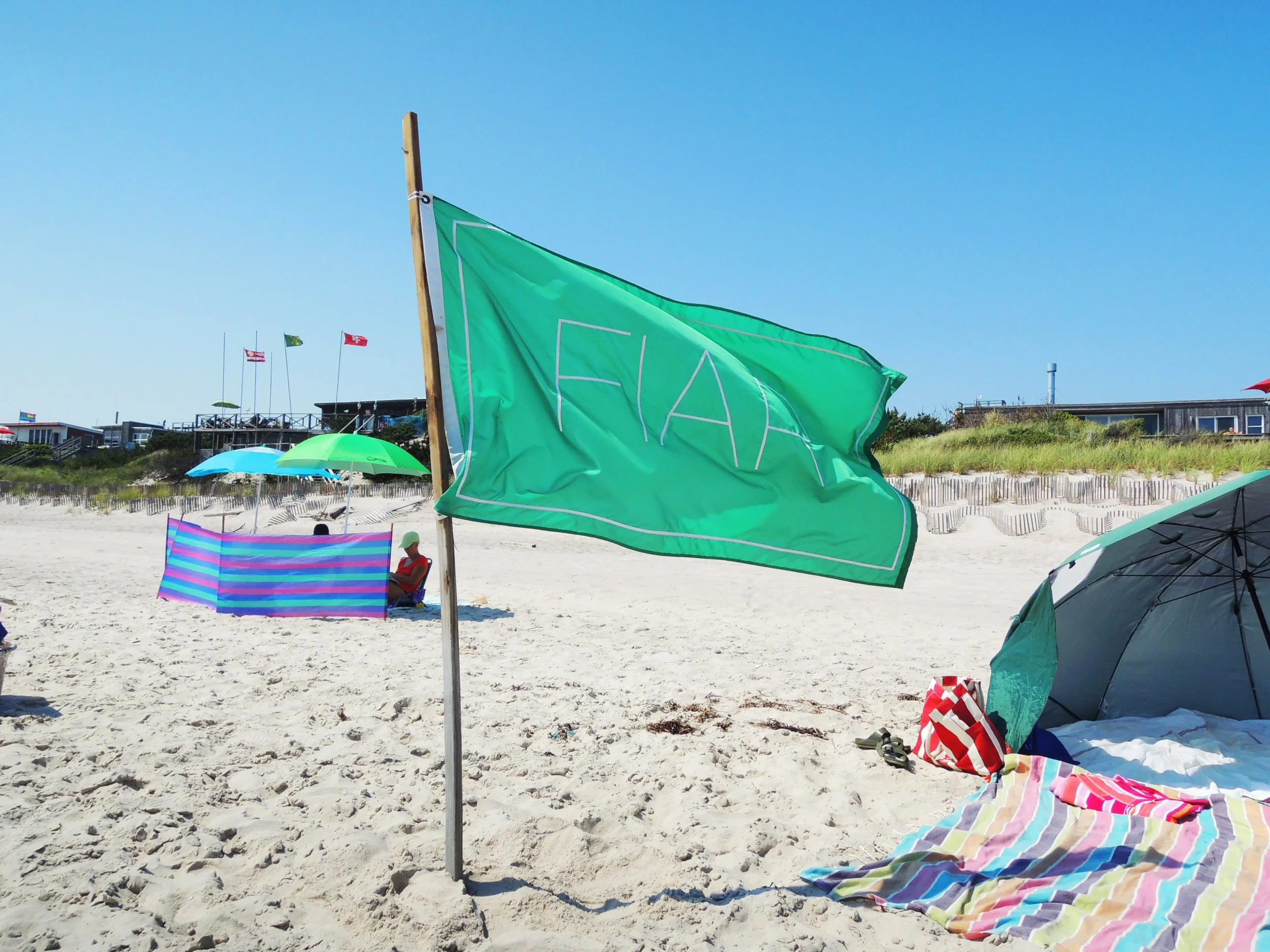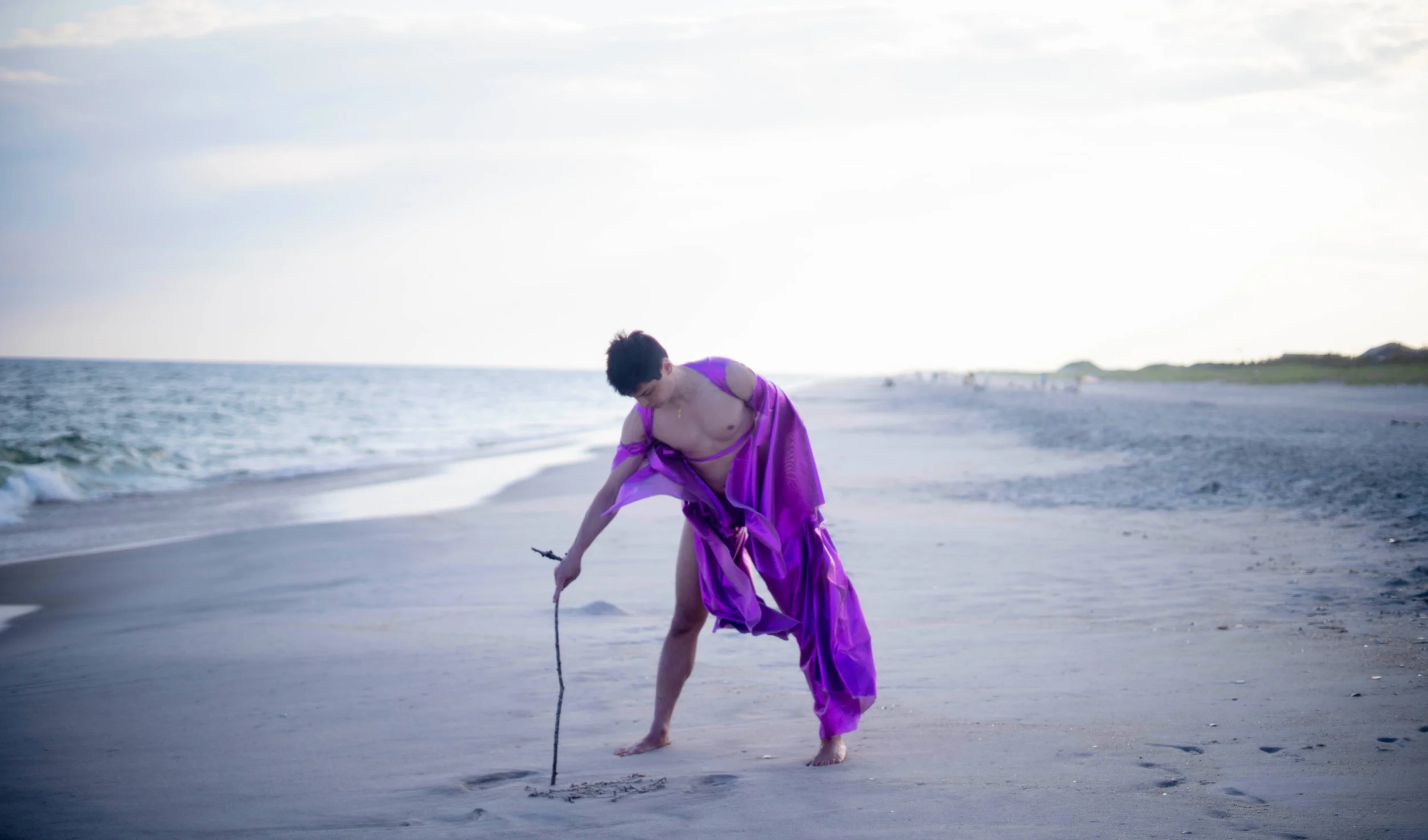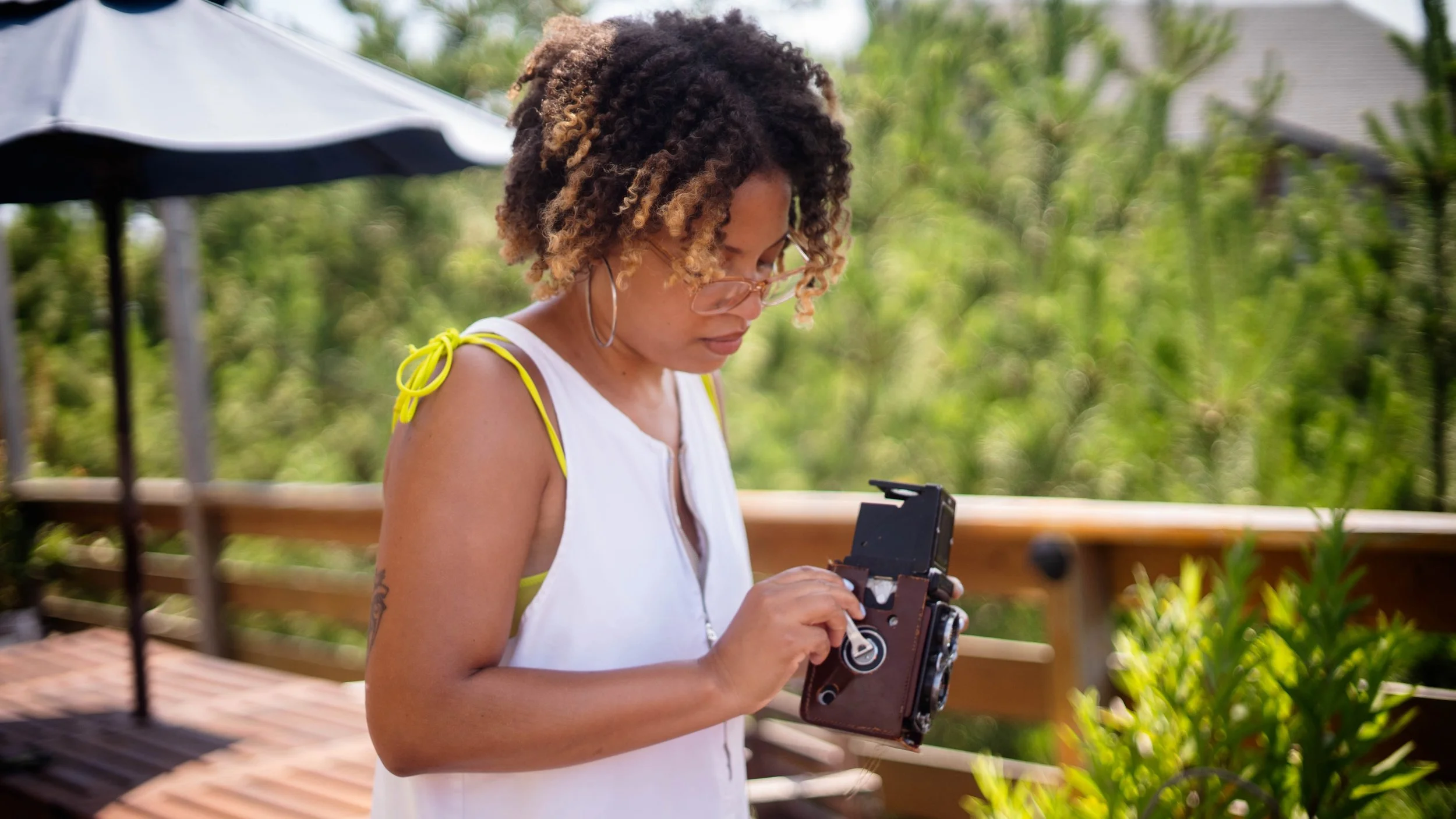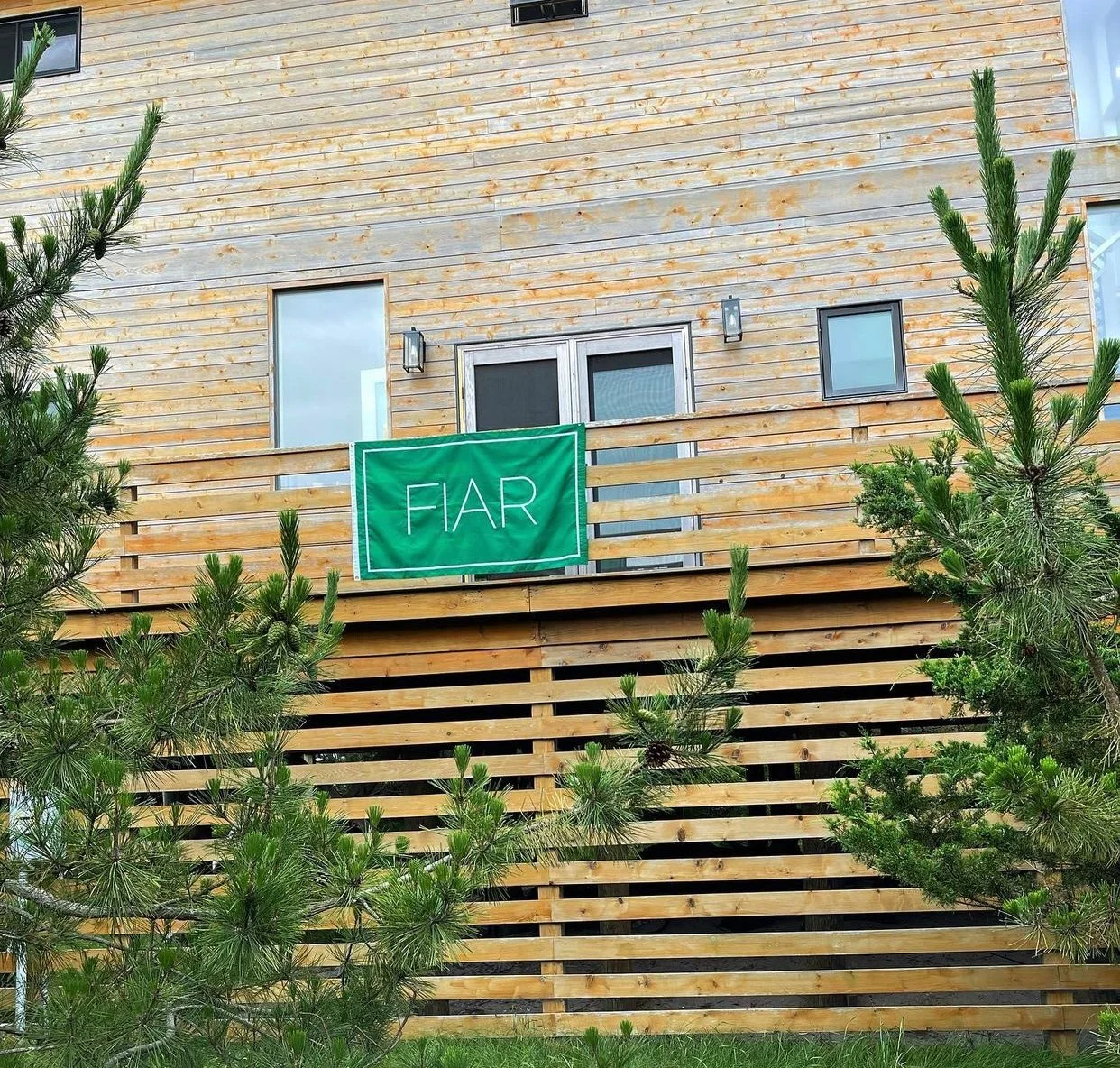The FIAR flag on Cherry Grove Beach. Photo: Chris Bogia.
Fire Island Artist Residency
Mission Statement: Fire Island Artist Residency (FIAR) is a non-profit organization founded in 2011 which brings lesbian, gay, bisexual, transgender, non-binary, intersex and queer identifying emerging visual artists to Fire Island— a place long-steeped in LGBTQ history— to create, commune, rest, reflect and contribute to the location's rich artistic history.
Interview with Executive Director Jeremy Steinke (he/him) by Andreana Donahue
FIAR 2022 Artists-in-Residence: (from left to right) Jen Everett, Sunny Leerasanthanah, Adam Liam Rose, Willa Wasserman, Darryl DeAngelo Terrell, and Moises Salazar. Photo: Justin Wolf.
Hi Jeremy! Thank you for talking with us. Can you share a bit about your background and how you became involved with Fire Island Artist Residency (FIAR)?
This summer will mark 25 years professionally for me in the contemporary art world. I’m an art historian by education and started my art career working in galleries in Soho in the late 1990s before going on to be the Executive Director of a private arts foundation and art collection in NYC for over 15 years.
In terms of my introduction to Fire Island Artist Residency, I knew the work of artist Chris Bogia and we became friends around the time that he and Evan Garza were presenting the second season of FIAR. Chris invited me to join the Board in 2013 and I served two three-year terms. When Chris decided to depart as Executive Director, he approached me about returning to the Board and helping to Chair the Selection Committee for the next Executive Director. During the pandemic we mounted a full executive search for the next ED and hired a wonderful and talented poet named April Freely. Very tragically on July 4, 2021 she suddenly passed away. As Board President at the time, I had plans to join April in her first week of the residency and therefore was able to step into the role quickly and welcome our residents as planned. With my fundraising and executive experience, I continue in the role, which is one I find inspiring every day.
FIAR’21 artist Vincent Chong performing “Whispers to the Ocean in Fuchsia” on Cherry Grove Beach. Photo: Rikki Porter.
Can you tell us about the history and founding of FIAR? What does a typical summer stay look like?
In 2011 artist Chris Bogia and curator Evan Garza, who were friends and enjoyed going out to Cherry Grove during the summers—first on day trips and then short weekend stays—were inspired by the deep-rooted LGBTQ+ history that was unique to Cherry Grove and from that the idea for FIAR was born. Its history is completely artist driven and is believed to be the very first residency exclusively in support of LGBTQ+ artists. Chris and his partner Rod now own a home in Cherry Grove and are integral members of the community of there. Chris was the Executive Director of FIAR for over a decade, before moving on to focus solely on his artistic practice.
This summer will be our 13th season in Cherry Grove. Each summer FIAR provides free live/work space to visual artists who work, socialize, and immerse themselves in the Fire Island community for four weeks, during which time they are visited by renowned artists and scholars, who interact with residents through intimate studio visits, dinners, and discussions, providing support and feedback. Visiting artists give lectures on their work, engaging in salons with artists-in-residence over communal house dinners, often with interested locals, and provide feedback to residents on their work and art-making practices.
FIAR’22 artist Willa Wasserman painting en plein air. Photo: Justin Wolf
I know Fire Island has a rich history and your programming is held in the Cherry Grove Community House, which is a landmarked LGBTQ+ historic site. Can you elaborate more on the significance and uniqueness of the residency’s location?
Ever since the 1920s, Cherry Grove has been the summer destination for artistic people of all kinds traveling from NYC, Long Island and beyond, which allowed this small island hamlet to grow into the first safe haven for queer folks on the east coast. In 1948, the Arts Project of Cherry Grove was founded and remains the world’s longest running LGBTQ+ theatre and arts organization. The Cherry Grove Community House is where all the FIAR public programs take place, bolstering everything that we do with this deep-seeded history.
FIAR is a non-profit dedicated to promoting the visibility of emerging LGTBQ+ artists and poets and providing free live/work space for meaningful, productive work. Can you talk more about your mission to ambitiously amplify these voices and create opportunities? How have you prioritized these goals?
For over a decade, FIAR has continued to serve emerging LGBTQ+ artists each summer with our seasonal residency in Cherry Grove, as well as expanding the program throughout the year with exhibitions in New York City, community-based initiatives such as Love Positive Women (a partnership co-founded by FIAR, Dieu Donné, Visual AIDS and the International Community of Women Living with HIV), curated film screenings, readings, panel discussions, and DEIA work. FIAR continues to push the boundaries of how organizations can serve queer emerging artists and communities devoted to contemporary art.
FIAR prioritizes creating equitable community at all levels of the organization, understanding and promoting the importance of being with queer peers. We strive to create opportunities for artists and thinkers to convene, share, restore and support one another both in their careers and in their lives.
Were you able to use the limitations posed by pandemic as an opportunity to reimagine the residency’s programming or shift priorities? Have you noticed a difference in the way artists engage with FIAR (or residencies more broadly) post-pandemic?
In 2020 we were unable to safely conduct a summer residency season, so we re-allocated the monies that we would have spent on the program to directly aid our former residents with financial stipends. I think the emotional and professional ramifications of enduring the pandemic will continue to unravel over the remaining course of all our lives, but what it did highlight for art residencies, and for FIAR specifically, is that community is sustenance for artists. More so, often artists seek out residencies in order to step away from their practice for a moment and rest and restore. This is also a very viable and necessary use of residency time, especially an unique one like ours which is on the beach.
FIAR’21 artist Naima Green working at one of the residency houses. Photo: Rikki Porter.
FIAR is a founding member of Rethinking Residencies, a working group of New York-based residencies. What are some notable outcomes of this collaboration and continuing dialogue?
FIAR is so honored to be a founding member of Rethinking Residencies, and more so the way the group of organizations has continued on supporting one another since its inception. During the pandemic RR was able to collectively fundraise for financial relief that was shared among all our organizations. This allowed FIAR to sustain and even thrive in the most difficult of circumstances.
A few of the bedrocks of this collaboration are resource sharing, knowledge sharing and once again community building, which inspires and strengthens all of our organizations. In 2021 we mounted the inaugural Rethinking Residences Symposium which was a great success, and the adjoining publication will come out this year.
Can you share some insight into the residency’s approach to community building and organizing, on Fire Island and beyond?
We believe that building equitable community is about participation and also about recognizing that we don’t always have all the right answers. We acknowledge that small non-profit arts organizations have growing pains and haven’t always been able to prioritize the necessary elements of care along the way. We strive to learn from those mistakes and grow better.
We also recognize that beach communities are often places where people have been continually excluded because of financial capacity, race, gender-identification, age and so on, so we prioritize what FIAR can do to make Cherry Grove specifically a more welcoming place for all people. We have a mandate for diversity in our Board, our cohort of artists-in-residence, our jury, our Visiting Artists, and in all aspects of our program. We challenge ourselves to provide support in this same way to other organizations in Cherry Grove to continually better the entire community, not just the arts community.
Among other initiatives, in recent years, we have participated in the inaugural and subsequent Juneteenth Celebrations on Fire Island and FIAR commissioned the first land acknowledgement specific to Cherry Grove in 2020, which is read aloud at each of our public programs.
In 2021 you launched the Fire Island Histories Project. Can you talk more about this ongoing series of commissions?
As an extension of our ever-deepening DEIA work, FIAR launched the Fire Island Histories Project, an on-going series of commissions by artists, historians, scholars and writers, whose mission is to mine the many complex histories of the place, peoples and communities who have populated Fire Island, from the original stewards of the land to the present day. The first commissions included an indigenous histories project with artist Jeremy Dennis, a lesbian narratives project with Dr. Esther Newton and Dr. Ksenia M. Soboleva in 2022, and this will be expanded with forthcoming histories of the Fire Island Blackout Weekend and of trans presence in Fire Island hamlets, among others.
Are there other residencies or spaces that have been influential to FIAR’s model, or that you’re just excited about right now?
Our peer organizations Visual AIDS and Queer Art Mentorship continually inspire and guide how to stay devoted to our mission and achieve greater impact in all aspects of our program. We also constantly look to our Rethinking Residencies peers such as Recess and Shandaken for organizational strengthening.
A residency that we are excited about right now was recently founded by FIAR’22 Visiting Artist Derrick Adams called The Last Resort Artist Residency in Adams’ hometown of Baltimore, which subscribes to the concept of leisure as therapy for Black creatives.
The FIAR flag on the residency house. Photo: Jeremy Steinke.
How do you cultivate meaningful relationships and overall robust community of artists during each summer session?
FIAR does not take artists and scholars to a remote place of pure quiet and contemplation. Our residency is rooted in the Fire Island communities of Cherry Grove and The Fire Island Pines, historically queer communities that are festive and social throughout the summer season. This inherent community in addition to the beautiful beaches and the national forest on this small islet provide a unique and immersive experience that many artists residencies cannot provide. These elements are built upon with our public programs and performances in the Cherry Grove Community House, which are always free and open to the public. Many of the stakeholders and homeowners in Cherry Grove are now of an older generation, so our FIAR community thrives on being inter-generational and bringing emerging artists and thinkers into play with those folks. Meaningful relationships are forged among the cohort of residences, along with the Visiting Artists and the Cherry Grove community at large.
Over the years you’ve amassed an extensive roster of artists and writers. Are there projects or works by past residents that you still feel excited about, or that most resonate with FIAR’s ethos?
I think one of the most memorable and impactful moments in FIAR’s history thus far is bringing artist Babirye Leilah from Uganda to Cherry Grove for the residency in 2015. From her experience at FIAR she was able to seek asylum here in the United States, as she was continually abused and threatened in her native country for her outspoken LGBTQ+ identification. Leilah now has a very thriving and successful art career.
There are also so many unforgettable and inspiring Visiting Artists talks from legendary LGBTQ+ artists such as Zachary Drucker, Nicole Eisenman, Chitra Ganesh, Jeffrey Gibson, Jim Hodges, Rashaad Newsome, Joel Otterson, Frederick Weston to name a few.
What have you learned during your time working with FIAR so far? How do you envision this residency and its endeavors progressing or expanding in the future?
There has been so much progress over the past decade in the LGBTQ+ community, but what I have learned from my time at FIAR is that there remains a great necessity to create safe spaces for queer folks to convene and inspire one another. Also, we continue to see our freedoms granted and then put into peril, so we need both our community and the arts more than ever right now. I see the powerful impact that the residency has on its artists, which confirms that our mission is an important one and we must continue to bring folks together in this very special place.
I think that for any non-profit organization entering its teenage years, the idea of sustainability weighs heavily on it. If FIAR could grow to a place in the next five years where we could have a permanent stake in the community that would be an incredible step towards organizational sustainability. A permanent home would mean a permanent presence for the non-profit in Cherry Grove. We would be able to expand the residency offering outside of visual arts to poetry (we had a two-year pilot program for poetry that was very successful), filmmaking, playwrighting, music, dance, the drag arts and on and on. That would be a truly beautiful thing.
Are there any upcoming programming initiatives, projects, or other news you’d like to share?
We are excited to welcome the 2023 summer residency cohort this July, which includes Marcel Alcalá, Elliott Jerome Brown, Jr., Caleb Craig, Joseph Liatela, Amina Ross, and Sara Stern. We also bring our second scholar-in-residence this year with the incredible queer scholar Kareem Khubchandani, who will bring their art, drag and performance event Dragistan to the historic Ice Palace in Cherry Grove, something the likes they have never seen before. In addition, we will be participating in the inaugural Cherry Grove Trans Weekend in September, and mounting an exhibition and series of performances with FIAR’15 resident Travis Boyer at the Carrington Cottage, in collaboration with the National Parks Service.
To find out more about Fire Island Artist Residency check them out on Instagram or on their website.
FIAR’17 artist Rodolfo Marron working at the residency house. Photo: Gregor Hofbauer.







